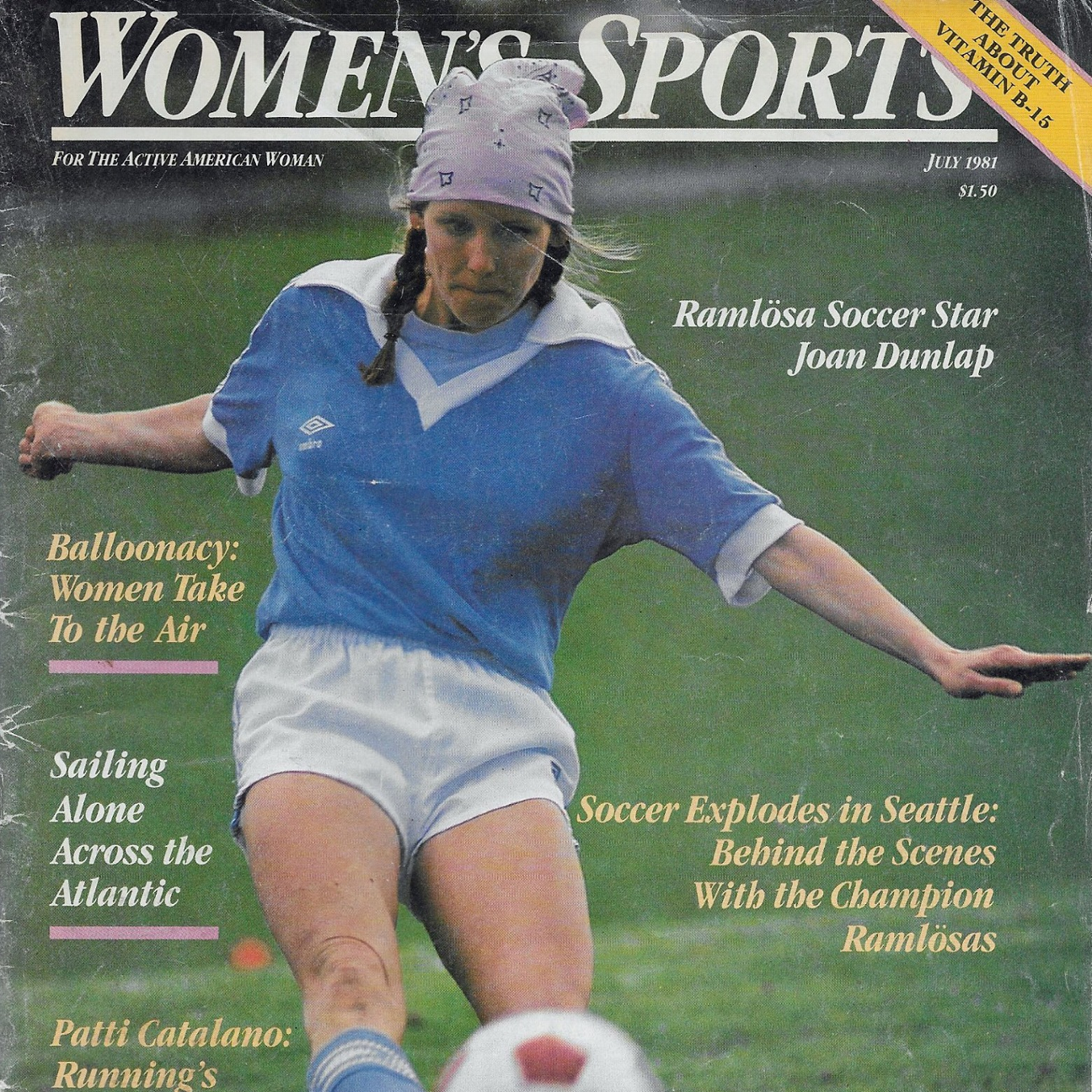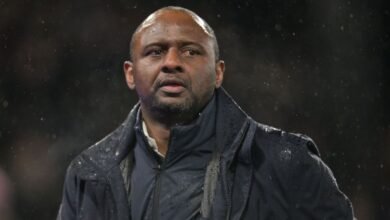USWNT history: Joan Dunlap paved the way for other mothers

[ad_1]
Flamingo Park, Miami. On June 27, 1980, the U.S. Soccer Federation holds the first U.S. Women’s Open Cup. There is not any nationwide crew, no skilled league, no NCAA championship — that is the highest degree of ladies’s expertise in the nation.
Joan Dunlap, 18 years outdated, is the star ahead for the Seattle Sharks. She wears a pink bandana over blond braids. A daughter of religious Catholics who would insurgent towards the stricture, she’s half Northwestern flower little one, half tomboy. And she’s breathtakingly quick, her first three steps as explosive because it will get. Joan Jett, they name her. She can outrun anybody, though — unbeknownst to the followers and most of her teammates — she is 5 and a half months pregnant.
Joan has by no means heard of somebody who competed whereas pregnant — there are not any examples to observe — however her physician gave her the inexperienced gentle, and she or he needs to win. She feels good, she’s not displaying, and since pace is her energy, she’s not too fearful about the bodily aspect of the sport — nobody can catch her anyway. The Women’s Open Cup closing ends in a impasse, and in the game-deciding shootout, Joan takes, and makes, the profitable penalty kick: the Seattle Sharks are nationwide champions.
Several months later, Dunlap offers delivery to her son, Johnny, and that second on the subject seems like a universe away. A self-described hopeless romantic, she as soon as believed she’d be together with her highschool sweetheart ceaselessly, however by the time her son is born, she is aware of she’ll be elevating him on her personal. She will always remember the day she left the hospital, the depth of how actual all of it is. She holds her new child in his gentle inexperienced onesie, pondering, Wow, right here we go. It’s simply you and me buddy.
What she does not know is that two years from now, a school coach all the way from Chapel Hill, North Carolina, will knock on her door and provide her, and her son, a house at UNC — thereby altering the programs of their lives. And that removed from it being simply the two of them, Johnny can have a crew stuffed with aunties and a one-of-a-kind, dream childhood with a whole campus who dotes on him.
As for Joan? She will go on to turn into the very first mom on the U.S. ladies’s nationwide crew — although you have nearly assuredly by no means heard of her. She’s from the misplaced era, the OGs who performed at the very starting, most of whom pale out earlier than anybody heard their particular person tales. (One of my favourite components about writing the essays for Pride of a Nation was stumbling upon all the tales I’d by no means heard earlier than, particularly these early years.)
Joan Dunlap was a maverick who adopted her dream and introduced her little one alongside for the journey, thereby lighting the way for all the player-moms who’ve come after her. Each era has made it extra potential for the subsequent and at present we’re in the midst of a bona fide child increase: the USWNT’s April camp included a whopping 5 mothers — Alex Morgan, Crystal Dunn, Casey Krueger, AD Franch and Julie Ertz. This quantity is particularly staggering when you think about that over the course of worldwide historical past, most ladies’s nationwide groups have had none.
Today’s era of gamers have the blueprint that Joan by no means had — they will convey their youngsters to camp figuring out that they are going to be watched by a nanny offered by the U.S. Soccer Federation. They additionally profit from a crew coverage that ensures them an opportunity to return after being pregnant: as soon as match sufficient to return, a participant is put again on the similar contract and can proceed to be known as up for not less than three months — sufficient time to show she nonetheless deserved her spot.
Back in the Nineteen Eighties, in fact, none of that existed. Joan Dunlap scored a purpose in her first sport with the nationwide crew — she bought chosen for the Copa Mundialito, “Little World Cup,” the place she performed each minute of each sport — after which disappeared from the historical past books.
When legendary Anson Dorrance first noticed Joan Dunlap fly up the subject, he did not know she had a 2-year-old son — he simply knew she was extraordinary. After the sport, he instructed her he’d like her to play for him at the University of North Carolina at Chapel Hill.
1:48
Rapinoe admits she’s pleased with substitute function at the World Cup
Megan Rapinoe remembers a dialog she had with USWNT coach Vlatko Andonovski about her function at the World Cup.
Dorrance would go on to win extra video games than any collegiate coach in the historical past of any sport, main the Tar Heels to 13 nationwide championships in the first 16 years. Because of that unimaginable dominance, he was appointed coach of the USWNT in 1986, thereby making UNC a direct pipeline to the nationwide crew. As the architect of the USWNT in the early days, Dorrance helped set up an angle and a personality that might be handed down from era to era, and he’d ultimately coach the U.S. to profitable the first ever Women’s World Cup in 1991.
But on that day on the sideline again in 1981, he was nonetheless inexperienced behind the ears, an audacious 20-something-year-old (not a lot older than Joan) who’d simply dropped out of legislation college to teach each the women and men’s soccer groups at UNC. In an period earlier than cellphones and the web, recruiting meant following suggestions and hopping planes.
“I was just beginning to learn where the hotbeds of women’s soccer were. Seattle ruled not only the northwest — they ruled the country,” Dorrance says. “This was not your classic youth team scenario. The spine of all these rosters were technically and tactically elite women.” The common participant was already in her mid-20s. They had been working class, salt-of-the earth kinds, powerful, gritty and in love with this sport they’d discovered.
Joan is the youngest of 5 youngsters and nobody in her household had ever graduated from faculty. When Dorrance first instructed her he’d like her to play for his crew, she thought it was humorous — she had a baby, she had no cash, how in the world would she be capable to go to school? Title IX, the landmark laws that requires colleges receiving federal funds to provide ladies and ladies an equal likelihood to play sports activities, handed in 1971, however by 1983 most schools didn’t but have soccer applications, not to mention soccer scholarships.
“How rare were women’s athletic scholarships back then!” Dunlap says. “I thought he probably had the wrong person or didn’t realize I came with a very special package.”
But when Dorrance discovered Joanie had a toddler, he was completely unfazed. He ate dinner together with her household and provided her a full scholarship — plus childcare and a house for Johnny.
To be clear, this wholehearted embrace of mom and little one was certainly not customary observe. Consider the method of many other coaches round the world — not too long ago ousted French nationwide crew coach Corinne Diacre forbid her gamers to convey their kids to camp. At the membership degree, simply this previous yr when Sara Björk Gunnarsdóttir bought pregnant, Olympique Lyonnais stopped paying her wage. After Australia’s Melissa Barbieri, a three-time World Cup veteran and nationwide crew captain, gave delivery, she known as each single crew in the Australian W-league, wanting for a crew — nobody needed her. When U.S. participant Amy Rodriguez was pregnant, Seattle Reign coach Laura Harvey took her to lunch and gave her a Reign child onesie — after which proceeded to trade her a month later.
In other phrases: many coaches need nothing to do with mothers. So for Anson — 40 years in the past — to say, Come, convey your little one, we’ll present a house and childcare and he may be with you on the sideline? It was downright radical.
“He was forward-thinking, didn’t let convention guide him — that’s what’s so great about Anson,” Joan instructed me. “The fact that he could look beyond all that, not judge, and see what could be. I am so grateful.”
Joan’s mother and father, her three older brothers and her older sister noticed her off to the airport. With her knapsack over her shoulder and Johnny in her arms, she took off for a brand new life on the other aspect of the nation, following the sport.
THE HUMIDITY AND HEAT had been a shock to the woman from Seattle. It was UNC’s preseason, three practices a day, and what she remembers most is the leaping — infinite leaping. In one train, they jumped over the ball, each toes collectively, side-to-side. Joan is earnest; she jumped as excessive and as quick as she may, explosive lateral leaps. One of the higher classmen did a double take, pondering, Wow, this woman’s not going to make it if she retains up like that. “Jesus Joan! Pace yourself!” Maybe do not leap so excessive.
Afterward a troublesome observe, she may barely transfer. Dorrance’s spouse, M’liss, had discovered Joan somewhat home down the hill from the hospital, a straightforward stroll alongside the purple brick sidewalks to campus. Johnny, who was additionally unaccustomed to the warmth, did not need to stroll residence — he needed Mom to hold him. Her legs had been jello. When she made it again, she’d lay out flat on the wooden flooring, her legs cramping, whereas Johnny climbed and jumped on prime of her. Suddenly she understood why her teammate had instructed her to tempo herself.
In the mornings earlier than class, Joan took Johnny to the church daycare on the fringe of campus — after class she picked up Johnny and headed to observe.
“She was like this mystery woman in a way — it was like, how do you do that?” says UNC teammate and eventual USWNT legend April Heinrichs. “She made taking care of Johnny, being a college student and being an athlete look effortless.”
#OTD 1983 – Seattle’s Joan Dunlap scores twice for North Carolina in 4-1 win over Radford. It’s the first of 23 straight video games Dunlap will both rating or help, together with NCAA championship sport. She does all of it with a 2-year-old son. pic.twitter.com/tD6ECTqnaY
— Frank MacDonald (@frankmSounders) October 15, 2022
The powder blue observe in UNC colours that surrounded Fetzer Field acted as an enormous playpen. Whoever was out injured saved an eye fixed on Johnny. He would perch on the bag of balls alongside the sideline, taking part in along with his vehicles in the lengthy leap pit, or coming out of a pile of leaves. That first season, Joan had some gnawing fear — she did not need to be an imposition. But sooner or later she started to consider everybody once they instructed her that having Johnny round made every thing higher. Everybody beloved taking part in with him — kicking him balls, or serving to him be taught his numbers.
The higher classmen had been arduous gamers, arduous drinkers, rowdy and aggressive. They lived on the edge, whereas the new class coming in had been all enterprise. The freshmen had been critically proficient, and any time you herald younger hotshots from round the nation who threaten the higher classmen’s taking part in time, there’s rigidity. But Johnny subtle it — and he humanized Anson.
Dorrance was lawyer-like — cool, intimidating. He wore a swimsuit and tie on the sideline of video games, and he recorded, charted and posted all performances, monitoring who gained every drill and who misplaced. He anticipated you to empty your self in the pursuit of excellence.
He additionally at all times arrived early — so when one afternoon observe started and Anson was nowhere to be discovered, there was teamwide confusion. They discovered him in the lengthy leap pit, on sand-caked knees, blowing bubbles for Johnny. The upperclassmen had been surprised: Anson was blowing bubbles?
7:17
Crystal Dunn anchors inexperienced however proficient defenders for USWNT
Kay Murray previews the goalies and defenders for the US ladies’s nationwide crew getting into the 2023 World Cup, together with Crystal Dunn, Alyssa Naeher and Naomi Girma.
Like her son, Joan too left an impression. She gave off a hippy, ethereal vibe – a blond halo of hair, shy smile. She wore her bandanas and her thrift-store jumpers with unthinking ease. Stacey Enos, a kind of hard-living upperclassmen, remembers connecting with Joan over music. It’s arduous to not think about it in gradual movement: pulling up of their respective VW bugs, feathered haircuts blowing in the wind, cleats tapping on the purple brick sidewalks as they sung songs by their favourite, Fleetwood Mac.
“She was so peaceful and calm, but then she got on the field and … f—, look out,” says Stacey Enos, a left-footed defender who would go on to captain the first U.S. nationwide crew in 1985. “She had this ability to see the ball and if you were in her way, she just went through you. She was ruthless. And her athleticism — she was on a different plane than anyone else. She could separate in the air — to launch up higher than anyone else. If you put a ball into the box, she finished it.
“I hated marking her and April [Heinrichs] — they had been the hardest matchups I ever had. April was like a horse, Joanie was a gazelle — each so quick … however Joan floated. I used to be so relieved to play in video games — it was a lot simpler than marking these two in observe.”
Dunlap and Heinrichs played side-by-side up top. Heinrichs describes Dunlap as “extremely quick, and so clean and technical.” Heinrichs, meanwhile, was a one-on-one specialist who could take anyone on the flank and possessed the requisite audacity to score goals; she’d go on to become a U.S. soccer goal-scoring giant. At the end of their first season at UNC, Heinrichs scored 18 goals and had 8 assists; Dunlap, with 15 goals and 12 assists, wasn’t far behind. They won the national championship with ease.
OFF THE FIELD, Joan fell in love: UNC lacrosse standout Joey Seivold remembers seeing her for the first time across the training room. “She had a degree of West Coast cool I discovered extremely enticing.” He saw her again on Halloween night. “Everyone was in wild, loopy costumes,” says Seivold, “and there she was, carrying a jean jacket — simply watching the idiocy unfold.” The next time he saw her, at a soccer party, he asked her out. Typically, she batted away all romantic proposals, but Joey’s was different — Joey wanted Johnny to come.
“I keep in mind him coming into our life — embracing it fully,” says Johnny, now age 41. That summer, the trio went on a camping trip in the Northwest, canoeing from site to site along the river. They have been together ever since. Maybe that’s when they knew — they would be together for the rest of their lives.
When Joan returned to Chapel Hill the following season, no matter fear she as soon as had about altered dynamics was gone: Johnny was very clearly a part of the crew.
“I mean, I was part of the fabric of the institution,” Johnny laughs. He was the 4-year-old on a school campus. “It was awesome. It felt so natural,” he says. His preschool was on prime of the hill on Franklin Street and he’d be on the jungle fitness center or the swings and his mother’s teammates would stroll by, calling him over to the fence to come back hang around. Anson’s father, who, one sport at a time, was recovering from his son dropping out of legislation college, would cease by and verify on them, a form of stand-in grandpa for Johnny.
The tightly-knit Tar Heels continued their reign of domination: Joan scored 21 objectives that second season with UNC. April scored 23 and gained National Player of the Year. Again, they gained the nationwide championship.
And then that was it — the finish. After two seasons, Joan’s clock was up, because of an archaic, now-defunct NCAA rule: a participant was solely eligible till the age of 24. She would nonetheless be on scholarship, would nonetheless end her schooling, however she would not be allowed to play in video games.
From her lounge in Chapel Hill, she watched on TV as her crew misplaced the 1984 championship to George Mason. From 1982 to 1994, it’s the solely NCAA title they didn’t win — it’s the blemish in the document ebook. “I never fathomed they could lose,” Dunlap says. She puzzled if she ought to have challenged that rule and fought the NCAA, which Anson had as soon as advised. Seeing her crestfallen teammates, she could not assist however really feel prefer it was her fault. Always, she was good for a purpose — that is not conceitedness. That’s truth. She nonetheless holds the UNC document for most consecutive video games with a purpose or help — a 23-game streak. If she’d performed, she would’ve made a distinction.
HER COLLEGE CAREER OVER, she saved taking part in anyway — coaching with the crew and taking part in in pickup video games. There had been murmurs of a U.S. ladies’s nationwide crew in the works and in 1985 it occurred: the very first U.S. nationwide crew traveled to Jesolo, Italy, to compete in the “Copa Mundialito,” Spanish for Little World Cup. The following yr, Dorrance was named coach of the crew, and you may guess he known as up Joan. She traveled to Minnesota for the USA-Canada Friendly Cup and in her first sport, she did what she’d at all times accomplished: she scored.
In the subsequent Copa Mundialito, in 1986, Joan was on the airplane to Italy; it meant she needed to depart Johnny together with her mom. Now 6-years-old, he was sufficiently old to know that his mother was going to play for the United States. “I don’t know if I fully understood the magnitude — but there’s no doubt that my mom was my rock star, my hero,” Johnny says.
Parts of that journey to Jesolo are foggy — it was almost 40 years in the past. There are snippets of off-the-field recollections — the Adriatic Sea, moped rides via the countryside — however extra vivid is the subject: “You don’t forget representing your country, wearing a jersey with the letters U-S-A. Singing the national anthem. The stadium full of fans, cheering for us. There’s clearly a different culture around the game in Europe, which we didn’t really anticipate,” Joan says. “I remember the swell of emotion, the pride.” She performed each minute of every match. In the earlier Copa Mundialito, they didn’t win a sport, however this go-round they beat China and Brazil and made it to the closing, the place they misplaced to Italy.
And the nationwide gamers got here residence and returned to their day jobs, their actual lives. In 1987, there was a lull, no funds to journey to play other nationwide groups, no nationwide groups touring to play them. Nothing was on the horizon. There had been sporadic gatherings, together with a coaching camp in the summer season, and she or he went, though a lot of the time journey was on their very own dime. It was value it — all of them thought it was value it.
But a baby, and being separated by an ocean, adjustments the equation. This was earlier than FaceTime, Zoom, and even cellphones. All you’d get had been one or two lengthy distance cellphone calls from a pay cellphone. “Kids are your barometer. It got harder and harder to justify being away. It put a strain on your family,” Joan says. “Was I really going to leave my child to go run around on a field, kicking a ball in Timbuktu?” At some level, her mother-in-law requested, really confounded, “Why on Earth are you doing this?”
At the finish of the yr, she and Joey took educating jobs in Lake Worth, Florida. Meanwhile, a brand new era of proficient youngsters was arriving. Joan thought to herself, simply let it go.
“Joan had huge promise, not just for my collegiate team but for the national team,” Anson says. “She was juggling a kid, a job, training, and nothing was set up for her to make an easy transition. There was no childcare or policies in place. This was pre-anything.”
Her complete era confronted comparable dilemmas: they’d paychecks to earn, careers to start — how lengthy had been they going to maintain this up?
“Joanie was just too good for the times. There wasn’t a place carved out for her yet,” says Michelle Akers, USWNT legend and fellow Seattleite, who was born three years after Joan. “For many of that generation, there was just nowhere to go — so they walked off into their lives.”
Joan can nonetheless clearly do not forget that subsequent chapter: when your id goes away, when all of your life you are a soccer participant after which instantly you are not — it is an expertise that transcends generations. There was the delicate dismay she felt when she stepped on the subject, now not in tip-top form, a shame to her former self — she had the similar inclination many aggressive elite athletes have: If you possibly can’t be at your peak, why play in any respect? I simply must cease. She targeted on educating, and training, passing down the sport.
BUT ANSON DID CALL her once more, in 1988: FIFA was placing on a pilot women’s World Cup in China, and he would love if she would compete for a spot. Hearing these phrases made her wistful. But by now she was pregnant together with her second little one. By the event, she’d be eight months alongside. No, she couldn’t go to China. The USA did not place at that competitors, dubbed the 1988 FIFA Women’s Invitation Tournament, and once more, Joan felt guilt. She puzzled, may I’ve made a distinction? Meanwhile, at residence, Johnny — now 8-years-old — challenged her to a race. Sure, his mother was billed by The Chapel Hill Daily as “possibly the fastest player in UNC history.” But now he was quick himself. And she was able to pop. He figured the time had come, that he was able to beat his mom. “She smoked me with her gigantic belly and I cried,” he says with fun. Now, this isn’t the place Joan’s story ends. In the summer season of ’92, she stopped by the Carolina Soccer camp and bought talked into taking part in in the nightly alumni sport, the place camp workers performs towards each other. Many had been nationwide crew gamers who had simply returned from profitable the ’91 World Cup, and though Joan hadn’t performed in a aggressive match in 5 years, she held her personal. Afterward, Anson caught as much as her, instructed her, “Hey, you still have it.” She laughed and blew it off, however a couple of days later she was nonetheless fascinated by it. “I couldn’t help but feel that I’d turned my back on my gift,” says Dunlap. She known as up Anson, requested if he meant it, if he thought she ought to give it one other go. One extra shot. “I absolutely meant it,” he mentioned. So Joan, a retired 31-year-old, by this level a mom of a 13-year-old and a three-year-old, had the audacity to mount a comeback. For 8 months, she instructed nobody what she was doing. She simply headed out to the observe with each youngsters in tow (as many U.S. soccer mothers will go on to do), in pursuit of her dream: making the 1996 Olympic crew. By 1994, Dunlap had fought her way right into a two-week nationwide crew camp in California, taking part in with the likes of Mia Hamm and Kristine Lilly. This new version of the USWNT had forwards in droves, and if she had a hope of creating the crew, she needed to convert herself right into a defender. One of the issues Anson beloved about Joan was her toughness; he instructed her to be bodily and she or he did that, tormenting her mark. “I was all up in her mug,” she acknowledges with a smile. The pissed off participant turned to Joan: “Hey old lady. Why don’t you go home to your kids?” She roomed with a pleasant Stanford participant named Julie Foudy, who was as outgoing as Joan was shy. While Julie was at all times on the transfer, Joan spent nearly all downtime on her mattress, icing her legs. “Julie was wonderful. But she must’ve thought I was whacko: I iced round the clock,” laughs Joan. Next, she was tasked with marking one Mia Hamm. Joan had at all times been sleek and clean, however she wasn’t fairly again to her outdated self and she or he felt a contact clumsy. She was petrified she would unintentionally injure Mia Hamm herself. She confessed this to Anson, who at all times checked in along with his gamers, and later he introduced it up in coaching, and now Joan fearful — oh no, does Mia assume I feel she’s weak, that she could not deal with it? At the pool, on an off day, she wore her bandana and her thrift-store jumper that she at all times wore — somebody mentioned, Nice outfit. Thank you, she mentioned, and solely later did she marvel in the event that they had been making enjoyable of her, the outdated woman at the pool in her secondhand garments. Lilly and Hamm got here to her room and requested, “Want to get ice cream with us? Or we could bring you some back.” She panicked and froze, her shyness taking on. She nodded, requested them to please convey some again. Immediately, she regretted it, beat herself up – why did I say that, why did I not go along with them? Were they reaching out? Trying to incorporate me? What was I pondering?? When she bought residence from camp, she had loads of time to mull it throughout: I should not have saved a lot aside, I ought to’ve tried to slot in, I ought to’ve gone for ice cream. She doesn’t get known as again into one other camp. While that end result wasn’t what she’d hoped for, she’s nonetheless proud: she went for it. And in the course of, she confirmed her two sons what it seems wish to be courageous. AFTER JOAN’S EXIT FROM the nationwide crew, Joy Fawcett turned the subsequent mother on the U.S. crew. She instructed Dorrance she needed to start out a household and that she “didn’t want to leave them at home and just take off.” Dorrance instructed her with out hesitation to convey them alongside. Teammate and defender Carla Overbeck joined the ranks of USWNT mothers in 1998, after each gamers requested the federation for assist, the USWNT turned the first crew to offer a nanny on the street for gamers — a landmark transfer. Since then, a complete of 17 mothers have performed for the U.S. nationwide crew. There had been rising pains alongside the way — after defender Kate Markgraf gave delivery to twins in 2009, then-USWNT coach Pia Sundhage instructed her that her contract wouldn’t be renewed, an expertise that led the USWNT Players Association to combat for a brand new coverage they’d nickname “the Markgraf rule.” As explained in the book “The National Team: The Inside Story of the Women Who Changed Soccer,” the coverage “guaranteed that if a player left the team for pregnancy, once she was fit enough to return, she would be put back on the same contract and continued to be called up for at least three months — enough time to prove she still deserved her spot.” Beginning with Joan, every era has made having a child extra potential for the subsequent. In July, three U.S. mothers will head to New Zealand to play in the Women’s World Cup: Alex Morgan, mother to 3-year-old daughter Charlee; Crystal Dunn, mother to 1-year-old son Marcel; and Julie Ertz, mother to 11-month-old Madden. While Joan was unable to convey Johnny to Jesolo, Italy, Dunn, Morgan and Ertz will be capable to fly their youngsters to New Zealand. There’s the crew nanny, the tiny jerseys with “MOM” bannered throughout the again, the parent-child photoshoots. And there’s FaceTime and Zooms, which means mothers are nonetheless in a position to see their youngsters even once they must be aside. While that have is completely different than Joan’s 40 years earlier, many particulars of player-motherhood stay the similar: like the crew of aunties doting in your youngsters and the need to share as a lot of your expertise along with your youngsters as you possibly can. After Joan’s video games, her son Johnny would tug her hand and lead her again to the subject, simply as Charlee takes Alex Morgan’s hand after San Diego Wave video games and tells mother it is her flip. Like their predecessors did for them, Dunn, Ertz and Morgan are displaying the future era what motherhood can seem like. As for Joan, at 61 years outdated, she’s nonetheless a free spirit, nonetheless typically wears her bandanas and her overalls, nonetheless listens to her music. She takes care of the neighborhood canines, enjoys gardening and loves on her new grandson. Looking again on her profession, she is nothing however grateful. And come July 21, sure, completely, she’ll be watching the World Cup — and the mothers who will take the subject.

[ad_2]
Source link





